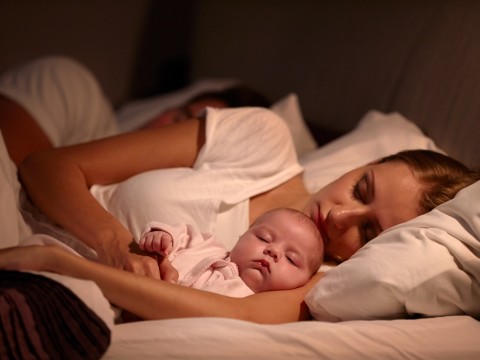

The Real Deal on Co-Sleeping with Your Baby

The concept of co-sleeping with baby is a topic that captures news headlines on a weekly basis. Sadly, many of the stories don’t have happy endings, so co-sleeping continues to have a serious social stigma.
But is there another side of the story that new mothers don’t hear as often? The reality is yes — there are lots of proven benefits to co-sleeping with your baby. You just need to follow safety guidelines when you do it. And, you need to understand the context of co-sleeping. It doesn’t necessarily mean sharing the same bed.
Room-sharing is the safest option
Instead of sleeping in the same bed as your baby, you can opt for room sharing. That means you sleep together with your baby lying on a separate surface (like a co-sleeper) within arm’s reach. Co-sleepers are designed to provide baby with a flat, cool, secure sleeping space that also contains and protects her.
Benefits of snoozing together
According to a recent article on WebMD, the American Academy of Pediatrics (AAP) says, “Evidence shows sleeping in the parents’ room on a separate, safe surface lowers the chance of SIDS by as much as 50%. It also helps prevent suffocation, strangulation, or entrapment that can happen when babies are sleeping in bed with adults.”
Co-sleeping helps mama too
Studies show sleeping in close proximity to baby helps keep the milk supply up for breastfeeding moms, alleviates separation anxiety and makes soothing a stirring baby (either by touch or by feeding) much easier. All of these benefits equal more sleep for baby and mama.
American Academy of Pediatrics safety guidelines
Co-sleeping deaths do happen, but they tend to occur in situations where risk in involved. If you’re co-sleeping with your baby, these are the golden rules:
-
Have infants sleep in the parents’ room, close to the parents’ bed but on a separate, firm surface designed for infants -- ideally until the age of 1, but at least for the first 6 months.
-
Don’t co-sleep your baby on the same surface if you’ve ingested anything that can make you overly tired like sedatives, alcohol or certain medications.
-
Remove pillows, sheets and any loose bedding items.
-
Sleep baby on a firm surface, which means it will not indent when you place your baby on it.
-
Don’t swaddle your baby if you’re sharing the same surface to avoid overheating your baby.
-
If you have long hair, make sure you secure it before you go to sleep, so it won’t get wrapped around your baby’s neck.
-
Don’t let siblings co-sleep on the same surface as your baby.
What real moms have to say about co-sleeping
Despite the stigma, informed moms know the benefits of co-sleeping – always following safely guidelines – outweigh the risks. We asked our sister brand Little Remedies® moms what they thought about co-sleeping and this is what they said:
“My baby is 20 months old and we are still co-sleeping.”
“I’ve always been a co-sleeper. I love the extra bonding time it gives me with my daughter.”
“I co-sleep with my baby now and did with my other 3 as well. I love it and having my baby close to me.”
We want to hear from our Boudreaux’s Butt Paste® mamas! Do you co-sleep with your baby? Share your story or tips for other moms with us in the comments section on our Facebook page.

